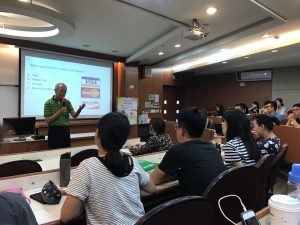In the morning of Jun 6th, the world known Professor Oded Shenkar gave a guest speech about his book called “Copycats”.
Dr. Oded Shenkar holds degrees in East-Asian (Chinese) Studies and Sociology from the Hebrew University of Jerusalem and a PhD from Columbia University. He is the Ford Motor Company Chair in Global Business Management and Professor of Management and Human Resources at the Fisher College of Business, The Ohio State University. Professor Shenkar has been a Senior Visiting Fellow at the University of Cambridge, and has taught at the Chinese University of Hong Kong, Hong Kong University of Science & Technology, Peking University, the University of International Business and Economics (Beijing), and the International University of Japan, among others. Professor Shenkar’s work has been cited by The Wall Street Journal, New York Times, Financial Times, Los Angeles Times, USA Today, Chicago Tribune, Washington Post, Boston Globe, Daily Mail (UK), Liberation (France), International Herald Tribune, Time, Business Week, Compass, the Economist, Chief Executive magazine, Associated Press, Reuters, Nikkei Financial Daily, China Daily, Reference News (China), and China Business Weekly, as well as on radio (e.g., NPR, CBS) and TV (BBC, CNN, CCTV, Reuters, ABC, Canada Business TV, Bloomberg).
During his guest speech, Dr. Shenkar kept the audience patiently listening and thinking of concept of innovation and imitation and their combinations – imovation.
Professor Shenkar introduced the book and explained that the way people think of imitation in business is different. The main argument of the book is that imitation is as important as innovation, they are complimentary, not two opposites (illegal forms of imitation are not in the book, the contents are strictly about the legal issues and places where legal systems are strong in protecting the IPR (intellectual property rights).
Most of the innovator companies are not in the market anymore or have only very small market share. The vast majority of businesses will look at the existing models and imitate it. Imitators are more likely to get more economic return than innovators, because imitating is much faster, more cost effective and more likely to provide with economic return.
Dr. Shenkar introduced a concept of Imovators = innovators+imitators (Imovation = fusing innovation with imitation), as well as pointed out importance for businesses know how to imitate wisely and for innovators to defend themselves from imitators.
The guest lecture was quite interactive and students couldn’t wait for Q&A session to begin, many of them had a lot of questions as it is a great opportunity to meet such a distinguished Professor in person.
Among the most interesting questions are the following:
Q1: In academic filed we study, read, add our opinion, improve previous research. Dr. Shenkar, In your opinion where does improvement go? Is it innovation or imitation or a combination of both?
A: In academic journals you don’t get a lot of credits for replicate studies. If you do, maybe you can publish in B or C journals. It is unfortunate. We should learn from the natural sciences. You put to test the gurus research and can find there is something wrong or there is a room for improvement. We should have the replications in our field.
Q2: AppStore, iTunes, SpaceX – these are all considered to be innovations. How do you think they could survive?
A: In the “Copycats” book it is not written about the big picture. It is for business entrepreneurs. Apple, for example, is a carefully done imitation (smart imitation which is done wisely, they looked at failures, drew a lesson, understood why and then acted). There is a lot to learn from failures, but management’s doors are usually more open to discuss success, but not failures.
Q3: There are companies, which start from imitators, but do not want to stay in this stage forever. How do you think they can move away from image of imitators?
A: There are businesses, which stay in “copycat stage” for a very long time. There are many examples of companies who keep on imitating for the whole business time. Some evolve into imovators. For example, P&G (Procter and Gamble) case: through their own imitation efforts they learned how to be good defenders from imitations. In P&G employees get a reward from anything that contributes to innovation, even if it is an imitation!
